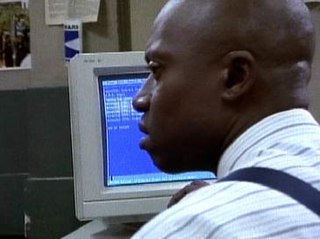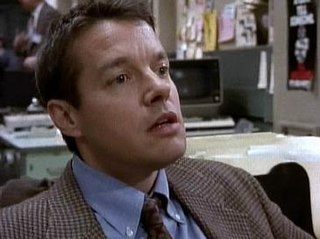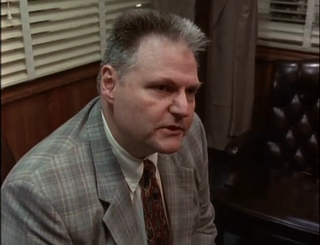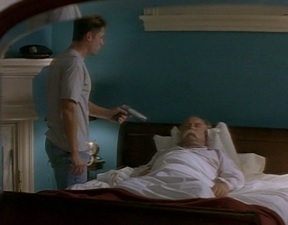Homicide: Life on the Street is an American police drama television series chronicling the work of a fictional version of the Baltimore Police Department's Homicide Unit. It ran for seven seasons on NBC from January 31, 1993, to May 21, 1999, and was succeeded by Homicide: The Movie (2000), which served as the series finale. The series was created by Paul Attanasio and based on David Simon's book Homicide: A Year on the Killing Streets (1991). Many of the characters and stories used throughout the show were based on events depicted in the book.

Francis Xavier "Frank" Pembleton is a fictional homicide detective on the television drama series Homicide: Life on the Street portrayed by Emmy Award winning actor Andre Braugher. He is a primary character of the show through the first six seasons. Although the show featured an ensemble cast, Pembleton would become the fan favorite and is often identified by as the show's signature character. He is based on Baltimore Police Department Detective Harry Edgerton, who, like Pembleton, was an eccentric New York bred African American detective in the BPD homicide unit featured in David Simon's book. Homicide: A Year on the Killing Streets. The character also appeared in the Law & Order episode "Charm City".

Timothy Bayliss is a fictional character on Homicide: Life on the Street, played by Kyle Secor and one of the few main characters to last the entire run of the show. He was loosely based on real-life Baltimore homicide detective Thomas Pellegrini, featured in David Simon's book Homicide: A Year on the Killing Streets, though Pellegrini was reportedly not at all a fan of his fictional alter ego. The character also appeared in the Law & Order episode "Charm City."

Roger Gaffney is a fictional police officer of the Baltimore Police Department on Homicide: Life on the Street. He was played by Walt MacPherson.
"Blood Ties" is the three-episode sixth season premiere of the American police drama television series Homicide: Life on the Street. The episodes constitute the 78th, 79th and 80th overall episodes of the series. They originally aired on NBC on October 17, 24 and 31, 1997, respectively.

"Subway" is the seventh episode of the sixth season of the American police television drama Homicide: Life on the Street, and the 84th episode overall. It first aired on NBC in the United States on December 5, 1997. In the episode, John Lange becomes pinned between a Baltimore Metro Subway train and the station platform. The Baltimore homicide department is informed that Lange will be dead within an hour and Pembleton tries to solve the case while comforting Lange in his final minutes.

"Gone for Goode" is the first episode of the first season of the American police drama television series Homicide: Life on the Street. It originally aired on NBC in the United States on January 31, 1993, immediately following Super Bowl XXVII. The episode was written by series creator Paul Attanasio and directed by executive producer Barry Levinson. "Gone for Goode" introduced regular cast members Daniel Baldwin, Ned Beatty, Richard Belzer, Andre Braugher, Wendy Hughes, Clark Johnson, Yaphet Kotto, Melissa Leo, Jon Polito and Kyle Secor.

"Three Men and Adena" is the fifth episode of the first season of the American police drama television series Homicide: Life on the Street. It originally aired on NBC in the United States on March 3, 1993. The episode was written by executive producer Tom Fontana and directed by Martin Campbell. In the episode, Pembleton and Bayliss have a 12-hour limit to elicit a confession from Risley Tucker for the murder of 11-year-old Adena Watson. The episode takes place almost entirely within the confines of the police interrogation room with the three actors.

"A Shot in the Dark" is the fourth episode of the first season of the American police drama television series Homicide: Life on the Street. It originally aired on NBC in the United States on February 24, 1993. The teleplay was written by Jorge Zamacona based on a story by executive producer Tom Fontana, and the episode was directed by Bruce Paltrow. In the episode, Crosetti focuses his investigation into the shooting of Officer Thormann on one suspect, while Lewis continues to investigate. Meanwhile, Pembleton and Bayliss pursue different leads in the murder case of 11-year-old Adena Watson.

"A Dog and Pony Show" is the sixth episode of the first season of the American police drama television series Homicide: Life on the Street. It originally aired on NBC in the United States on March 10, 1993. In the episode, Pembleton and Bayliss investigate the murder of a police dog, Crosetti helps his friend adjust after a serious injury, and Felton and Howard suspect a drug dealer for a brutal murder.
"And the Rockets' Dead Glare" is the seventh episode of the first season of the American police drama television series Homicide: Life on the Street. It originally aired on NBC in the United States on March 17, 1993. In the episode, Howard testifies in a murder trial, Pembleton is offered a promotion, and Lewis and Crosetti go to the Chinese Embassy in Washington, D.C. to investigate a political refugee's murder.

"Smoke Gets in Your Eyes" is the eighth episode of the first season of the American police drama television series Homicide: Life on the Street. It originally aired on NBC in the United States on March 24, 1993. In the episode, Howard and Bayliss attempt to quit smoking, Gee discovers secret asbestos removal in the squad room, and Munch and Bolander investigate the beating death of a 14-year-old boy. The episode was written by James Yoshimura and Tom Fontana, and was directed by Wayne Ewing, who doubled as director of photography.

"End Game" is the 14th episode of the third season of the American police drama television series Homicide: Life on the Street. It originally aired on NBC on February 10, 1995. The episode was written by Rogers Turrentine and directed by Lee Bonner. The episode continues a storyline about the shooting of Beau Felton, Kay Howard, and Stanley Bolander.
"The Gas Man" is the season finale of the third season of the American police drama television series Homicide: Life on the Street. It originally aired on NBC on May 5, 1995. The episode was written by Henry Bromell and directed by Barry Levinson. The episode focuses on characters played by guest stars Bruno Kirby and Richard Edson, with the detectives who normally serve as the protagonists here serving the function as secondary characters.
"Law & Disorder" is the 15th episode of the third season of the American police drama television series Homicide: Life on the Street. It originally aired on NBC on February 24, 1995. The episode was written by Bonnie Mark and Julie Martin and directed by John McNaughton. The episode concludes elements of a storyline about the shooting of Beau Felton, Kay Howard, and Stanley Bolander.

"See No Evil" is the second episode of the second season of the American police drama television series Homicide: Life on the Street, and the eleventh overall episode of the series. It originally aired on NBC in the United States on January 13, 1994. In the episode, Felton's friend kills his father in an assisted suicide, and Felton tries to convince Lewis to look the other way. In a subplot, Pembleton investigates what appears to be the police shooting of an unarmed suspect.
"Black and Blue" is the third episode of the second season of the American police drama television series Homicide: Life on the Street, and the twelfth overall episode of the series. It originally aired on NBC in the United States on January 20, 1994. In the episode, Pembleton aggressively investigates what he believes to be a police-related shooting. Amid pressure from Gee to pursue civilian suspects, Pembleton elicits a successful confession from an innocent man, leaving Gee feeling conflicted. Directed by Chris Menaul, the episode's teleplay was written by James Yoshimura based on a story by series executive producer Tom Fontana.
"Nearer My God to Thee" is the third season premiere of the American police drama television series Homicide: Life on the Street, and the fourteenth overall episode of the series. It originally aired on NBC in the United States on October 14, 1994. In the episode, the homicide department is assigned to the politically volatile murder of a beloved social worker, whose body is found wearing nothing but a pair of white gloves. Meanwhile, Felton struggles with marital problems, while Lewis and Munch try to find a business partner with whom to open a bar.
"Fire" is the season premiere of the fourth season of the American police drama television series Homicide: Life on the Street. It originally aired on NBC on October 20, 1995. The episode was written by Julie Martin and was directed by Tim Hunter. The two-part story centres on Pembleton and Bayliss' investigation into a pair of arson-related homicides, and introduces a new regular character, Arson Squad detective Mike Kellerman, who subsequently transfers to Homicide and partners with Det. Meldrick Lewis. This episode also flagged the permanent departure of regular characters Stanley Bolander and Beau Felton.
Barnfather is an English surname. Notable people with the surname include:










